
Embracing the Past
What should you know about buying antiques?
12/24/2012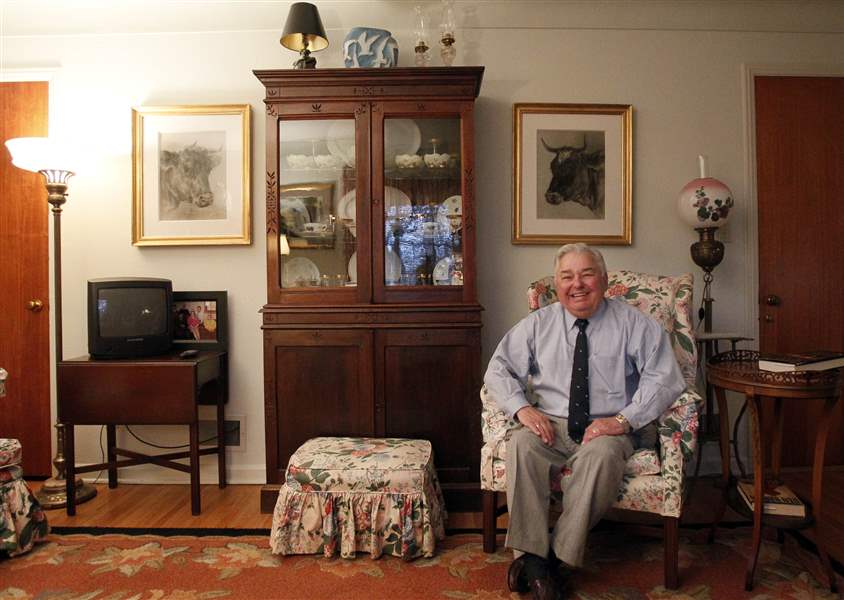
Barney Stickles decorates with antiques in his home. Study before you buy, he says.
The Blade/Amy E. Voigt
Buy This Image
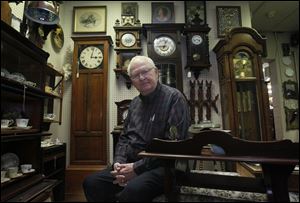
Ted Powers is surrounded by treasures from the past at Ancestor House Antiques, which he owns with his wife, Sheila.
Toledo antique dealers won’t sell an item as an antique unless they are certain that it is exactly that: an antique. That’s Connie Hoffmann’s observation about her colleagues and competitors in the business.
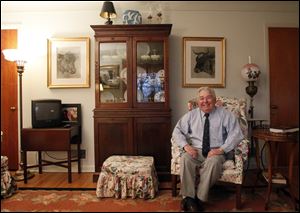
Barney Stickles decorates with antiques in his home. Study before you buy, he says.
“Most of those in town have integrity,” said Ms. Hoffman, owner of Adams Street Antiques.
She learns from her customers and consults with trusted professional peers for insight about items that some might disregard as simply “old.” One of the most knowledgeable people in the area on antiques said that a novice interested in making such purchases should first learn about them.
“Just because something is old doesn’t mean it’s an antique,” said Byron “Barney” Stickles, an antiques appraiser. “There was junk made in the old days as well as now. It takes 100 years to be an antique.”
The Federal Trade Commission stipulates that something must be a century old to be called an antique, and other dealers say that something that is at least 50 years old is considered “vintage.”
“Usually there’s a blurring of the lines,” said former Detroiter James Valentine, owner of Valentine Antiques, 1505 Adams St. “The word ‘vintage’ is almost a new definition and no one has put a concrete definition to that word yet.”
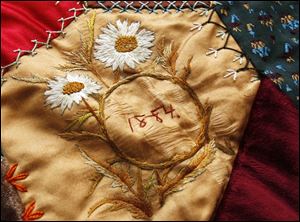
A hand-stitched quilt made by Barney Stickles grandmother Bertha Hirsch in 1884.
Though it takes years of experience to readily identify antiques, before setting out to make a purchase, inexperienced buyers must read up on the subject and talk with reputable dealers.
“Study,” said Mr. Stickles, who once owned Style-Rite Lampshades. “You will make a few mistakes, but don’t be afraid to make a mistake. If you buy quality, it will not hurt. If you buy quality and you overpay, you will recover.”
Mr. Stickles — who developed a love for antiques as a child growing up in a home filled with them — suggests looking for items that are signed, but he notes that not all antiques have a signature.
“Sometimes things are not necessarily signed, and that’s where experience comes in,” he said. “You look for workmanship. People today make beautiful things that will be wonderful tomorrow.”
Mr. Valentine concurs.
“You want to look for quality,” he said, adding that an item should also be visually appealing. “You can look for quality and something that is appealing at the same time.”
Those without years of experience in buying antiques might also bear in mind these points from Mr. Valentine: Close examination of a piece billed as an antique reveals the quality of workmanship. Is furniture held together with pegs and is there dovetailing? Are there hand-carving marks?
“You look underneath and if you see pressed board, it’s a sign that it’s not old. If you see staples and screws, it’s not old. And if you see ‘Made in China,’ it’s probably not old. That’s a good way to eliminate a lot of things,” added Mr. Valentine, who studied veterinary medicine at Wayne State University. He became fascinated with antiques during his undergraduate career when he worked for a dealer.
Not everyone who buys antiques is ignorant of the field.
“Most of my customers are knowledgeable,” Ms. Hoffmann said. “The ones who aren’t, I’m usually able to help them. We have books to look items up in. One way to tell is by the markings. Like Libbey. All Libbey is signed; you can find a signature on it.”
Serious antique buyers also know that it’s a good idea to talk with dealers, too.
“There are good dealers and bad dealers,” said Ted Powers of Ancestor House Antiques on Tremainsville Road. “Bad dealers usually don’t know what they are selling to begin with.”
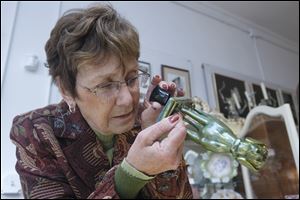
Connie Hoffman inspects markings on the bottom of a small piece at her shop, Adams Street Antiques.
Mr. Powers has been enamored with antiques since he was in early elementary school. He urges the unskilled to check dealers with the local better business bureaus, chambers of commerce, and museums.
Mr. Stickles warns buyers to be wary of antique furniture that’s been stripped and refinished, because those processes can depreciate a piece by as much as 50 percent.
“In most cases, you don’t refinish but you protect the original patina, the original finish,” Mr. Stickles said.
People from all demographics buy antiques.
“Antique buyers are average, educated people who appreciate fine things,” said Mr. Powers. “They are cab drivers, refuse drivers, nurses, and doctors.”
And not all antiques are expensive, said Mr. Valentine.
“People of all kinds look for antiques,” he added. “I’ve bought antiques and I don’t have a lot of money. Not all antiques are expensive. They can be expensive, but they don’t have to be.”
Contact Rose Russell at: rrussell@theblade.com or 419-724-6178.